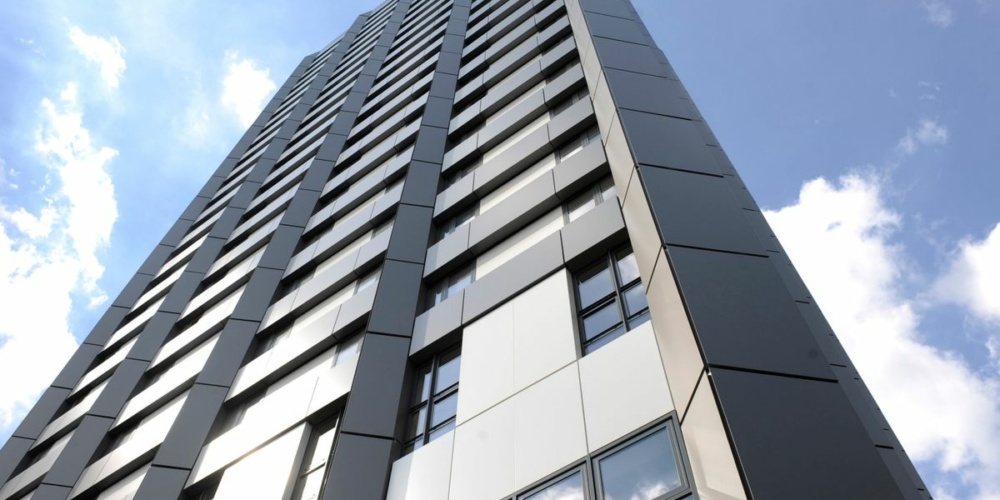Following the devastating events at Grenfell Tower in London, a significant amount of work has been undertaken by the government to review and advise on building safety across the country. This has focused around the fire safety of external wall cladding systems on buildings that are over 18m in height and do not incorporate Aluminium Composite Material (ACM), which is covered in a separate advice note. The result of this work was the issue of Advice Note 14 (AN14) that stipulates the wall system has to achieve BR135 classification via a BS8414 test. Essentially this translates to any building that is over 18m and comprises of an external wall system must be tested, and achieve a certain level of safety to satisfy these recently established levels of fire safety.
So, what does this mean and what have the effects been?
In reality, a significant amount of buildings that fall into the criteria within the advice note were constructed at a time when these parameters were not in existence, which means that whilst they satisfied the building safety specification at the time of construction, they would not do so at this time. Therefore, once a test has been undertaken, and it fails the test against the above standards it immediately presents a challenge for all stakeholders in the building.
From a residents’ perspective, the largest and most immediate impact has been the ripple effect onto property sales and those looking to re-mortgage. A growing number of lenders are now seeking reassurance that buildings comply with the advice note before funds are secured against the property in the form of the mortgage. Frustration levels amongst consumers is growing and people are becoming trapped and unable to progress with their sale. Furthermore, mortgage providers are often valuing apartments at £0, which serves to compound the fear and anxiety of the whole situation. The move to “zero-value” an apartment is a standard step by the mortgage lenders to halt their process; nevertheless, the thought that the apartment you own may have lost all value overnight is very concerning scenario.
In an attempt to help expedite this, the ‘Ministry of Housing, Communities and Local Government’ (MHCLG) has chaired multiple consultations with key stakeholders across the industry in an attempt to unblock this current situation. More recently, a new EWS1 form has been released that lenders can rely upon where a ‘suitable professional’ can deem the building compliant, but takes on liability for their report with the lender. This, in turn, has created its own challenges whereby said professionals’ indemnity insurance has sky rocketed and in some cases has been withdrawn fully.
The concern around cladding is, of course, warranted but it is worth noting that AN14 is an advice note – a recommendation – rather than legislation. The industry should be looking to make this a standard and, collectively, finding the most straightforward solutions.
In some cases, however, it does involve large scale and costly projects to remove the existing system and replace it with something new and compliant.

BS8414 test on external cladding
So, who pays for this work?
With buildings that have been in existence for some time, the developer will have long moved on and will have obligated with the construction requirements at the time of the building going up. That said, in some of the cases that have arisen, the developer has taken the decision to return to the building and fund the required works. It must be stressed that this action is through goodwill and not a given in all cases. In the scenario where third party funding does not materialise, this will more often than not fall to the responsibility of the residents to remedy. Collecting funds for an un-budgeted large-scale project will take time, as well as the project management resource required to discharge what is often a complex piece of work. This is, sadly, not an overnight fix.
If your building has failed its recent test and the local fire authority have reviewed the report that was created from the assessment, there will be immediate requirements to mitigate the newly established risk, regardless of the above. This could manifest itself as a waking watch (manned patrols of the building at all times) or the installation of a suitable fire system above and beyond what is currently there. This will need to again be funded by the residents if the developer is not willing to return and undertake the required works, but will be implemented as a priority.
So, where does this leave us? Unfortunately, there is no silver bullet solution. For those looking to remortgage or sell, the process may be longer than hoped with costs involved to reach a point that allows you to move forward. Not all lenders are being as strict with AN14, so shop around and you may find a lender happy to move forward. Your managing agent that looks after your building – such as Centrick – should have a clear process to handle this scenario to ensure that things progress as swiftly as possible, and robustly protect the interests of everyone in the building.
The environment is evolving and Centrick is keeping abreast with progress to offer clear and transparent advice to our customers along the way.
If you would like free advice or to discuss further, feel free to get in touch with us today.









